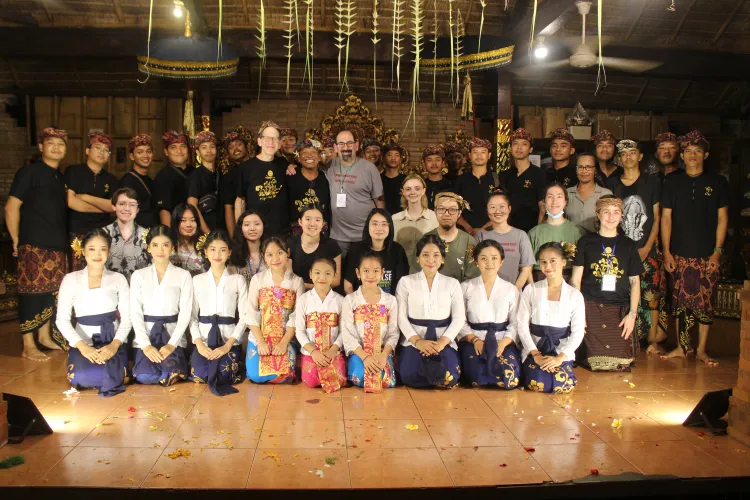Reflection on the Gamelan Embedded Study Program in Bali

Participants of the Swarthmore Embedded Study Abroad Program with members of Gamelan Çudamani in Pengosekan, Bali, Indonesia
Despite being in the Gamelan group and having the Embedded Study Abroad trip on my radar since last spring, I couldn’t believe that I would be traveling to Bali with my fellow Swarthmore students over winter break. As we boarded the plane to fly over the Arctic and toward the tropical island, I felt gratitude and anticipation, but I was also aware that I was diving headfirst into a total unknown.
Stepping out of the airport on arrival, I understood why it had been so hard for me to conceptualize and prepare for the trip. The beauty of Bali is so immediately arresting, so expansive yet so intricate, that it overwhelms the senses. The nature is astounding, with sky-high trees and green bursting out of the seams of every street corner; technicolor flowers and hanging vines that drape like dense curtains of thriving life. But what is more awe-inspiring is the way that art — a tribute to human ingenuity and expression — is as pervasive as the leaves on the trees.
As we drove to Pengosekan Village, the home base for our music practice, I marveled at what I saw outside the window. The road medians and streetlights were covered in characteristically beautiful wood carvings, a tribute to the small artistic details that enrich the most mundane circumstances in Bali. We passed grand statues of Hindu gods, covered in gold, fringes, and flowers. Temples were on every corner, each one a compound, filled with decorations, painstaking stonework, and small woven baskets of multicolored daily offerings to the gods. Later, I found out about the massive investment of time, money, and craftsmanship it takes to construct and maintain a single temple.
The relationship between community and art is deeply intertwined in Bali. It is natural to invest in art because it means you are also investing in your community and your family. As the trip unfurled, Çudamani—the performing ensemble that designed and led the music program for us—brought us into their community and made us feel at home. Every day, we walked from the guest house to the Çudamani compound, where we were greeted with warm smiles, patient guidance, and delicious home-cooked food. I had not been able to dedicate so much concentrated time to music before; it felt natural being surrounded by our teachers who had been playing Gamelan since before they could remember. The program was led by musician, composer, and teacher Dewa Barata. His infectious smile and enthusiastic, yet unhurried energy ensured that we took in every new note, smiling alongside him the whole way. The pace of life in Bali made us slow down and appreciate every moment, something that we busy Swarthmore students often struggle with.
One of my favorite features of the Gamelan instruction we received was the ability to try a wide variety of instruments, with personalized instruction on each. There are roughly twenty-five different instruments in Balinese Gamelan. The melodic core of the ensemble is a set of metallophones with different pitch ranges and names, which is what the majority of the students at Swarthmore play. However, there are also a variety of drums, gongs, cymbals, and even the bamboo flute (suling). At Çudamani, we got the chance to rotate on different instruments, many of which I had been too intimidated to try beforehand. At our final exhibition performance, we played a variety of different songs that showcased them. Returning to Swarthmore, I am now able to be a leader in the ensemble, as I feel confident playing on all of the instruments.
Aside from the excursions and day trips we took, the most impactful part of the trip was the home and community of Çudamani and Pengosekan. Our trip leader and Swarthmore Gamelan instructor, Professor Tom Whitman, helped build bridges between us and people he’s connected with over his years visiting and living in Bali. To visit a place, not as a tourist but as a student, and eventually a friend to the people living there, is to know the place on a deeper level. Despite our short amount of time on the island, many of us formed relationships with our Balinese friends that will continue to bloom and grow long beyond the trip. I have built a deeper affinity for gamelan as an art form than I ever imagined—it will be a lifelong link between me and the people I met in Bali.
We were impacted by other cycles of life while we were in the community at Pengosekan. One community member, a neighbor of Dewa Barata, passed away during our stay. Following Balinese funerary customs, we were invited as guests to the life celebration and cremation, where we witnessed the way that art, music, and dancing are omnipresent even through expressions of grief and loss. A close friend of Tom’s also passed away, I Wayan Rai, who was the guiding force and inspiration behind the formation of Swarthmore Gamelan. We will honor his life at our concert this spring. These unexpected losses brought us together and deepened our understanding of the cycles of life, which are so sacred in Bali. They say that there are no coincidences in Bali, and everything has a purpose.
Ultimately, this trip was about more than gamelan. It was an opportunity to learn about spirituality, hospitality, friendship, and Balinese culture. I am so grateful to Swarthmore for supporting this program, Tom Whitman and Jon Kochavi for being our trip chaperones, and all of the members of Çudamani for guiding us through the experience.



